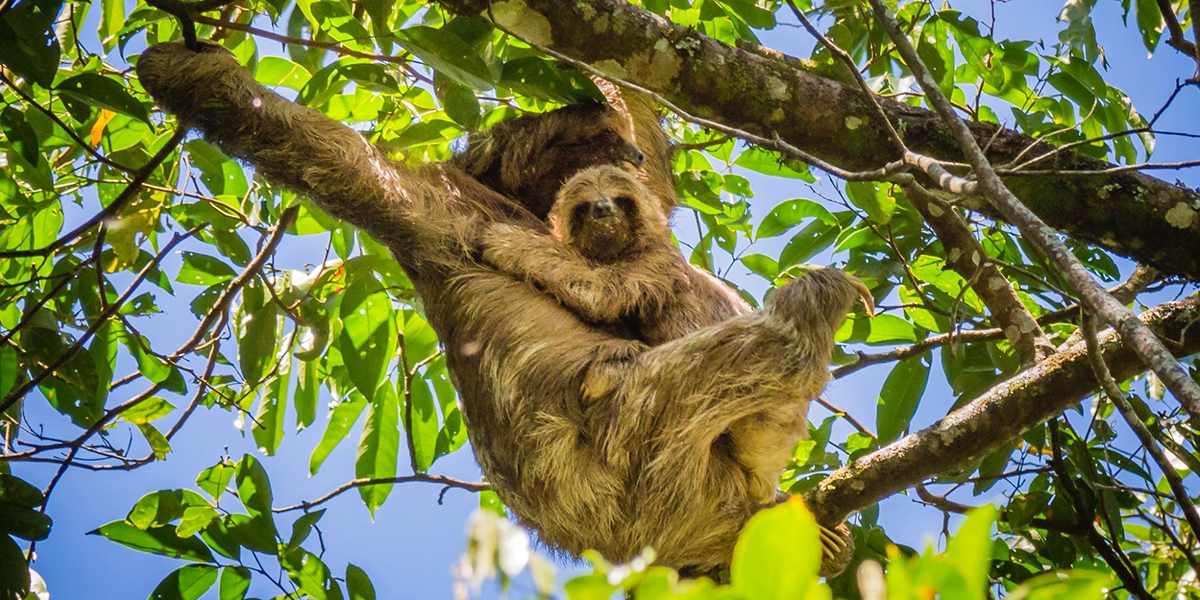All About Sloths!

If there is one question that we in the tourism/hospitality industry get a LOT, it’s “Where do I go to see sloths?”
There is just something mysterious and fascinating about these slow-moving creatures, and people just can’t wait to see them and to learn the answers to questions like,
-
Why do they move so slowly?
-
What do they eat?
-
How can they avoid predators when they are so slow?
-
Why do some have 2 toes, while others have 3?
In this post, we will answer these questions and more, so that when you visit, you will know exactly what to expect… and where to look, to get a good look at these adorable critters.
Sloth 101| Getting to Know These Slow Moving Creatures!
.jpg?width=800&height=480&name=Sloth%20(6).jpg)
What is a sloth?
The word “sloth” comes from the Middle English word for “laziness” which tells you a lot about the animal itself.
A sloth is a type of xenarthran mammal, which in scientific terms means they exist in the suborder Folivora. There are two types of existing sloths: the 2-toed sloth (of the genus) Choloepus, and the 3-toed sloth (of the genus) Bradypus.
There are two types of 2-toed (the Hoffman’s and the Linnaeus’) and 4 types of 3-toed (the pygmy, maned, brown-throated and pale-throated). Both types have three toes on their rear limbs, it is only the front limbs that are different.
Believe it or not, these two creatures are only distantly related and it’s widely believed their similarities are due to something called convergent evolution. This means that each of the two species developed similarities due to cues from their environment and their evolutionary needs. In this case, long arms ending in clawed feet which they use to climb trees and forage food.
In all, there are 6 species of tree sloth, all of which reside in the tropical regions of Central and South America.
An interesting fact that isn’t widely known is that the closest living relative of the sloth is actually the anteater! This makes much more sense when you learn that, before they became extinct 12,000 years ago, there were ground sloths! What is even more surprising is that one particular type of ground sloth, the Eremotherium eomigrans was bigger than an African Bush Elephant!
Of the two, the 2-fingered sloths are larger with an average weight of 4-8 kg. They are also faster moving than their smaller cousins.
Why Are Sloths So Slow?
According to the experts at the Sloth Conservation Foundation, they move slowly because they can’t see very well. Like their distant cousins, the anteater, sloths suffer from rod monochromacy a condition that prevents them from seeing colors.
When the species took to the trees thousands of years ago, they had to learn to move slowly to avoid falling… and it must be working because the sloth has been around for 64 million years, emerging almost immediately after the extinction of the dinosaurs.
.jpg?width=800&height=480&name=Sloth%20(5).jpg)
What Do Sloths Eat?
Another reason for the sloth’s slow pace has to do with what they eat. Sloths are florivorous, meaning they eat mostly leaves. These leaves don’t provide a lot in terms of calorie intake, and when you combine that with the extremely slow rate of digestion caused by their large 4-chambered stomach you start to understand… they’re full most of the day!
Scientists guestimate that it takes 1,200 hours to digest any given bite of food! Which explains why they only need to defecate once a week. Since relieving themselves means a trip to the ground, and being on the ground makes them vulnerable to predators… this evolutionary trait seems pretty smart.
How Slow Are They?
At top speed, a sloth can travel 1.5 miles an hour. But that’s only at an all-out “sprint”. On average, sloths travel through the canopy at a rate of just 40 yards PER DAY, partially because they spend 15-20 hours of each day sleeping.
How Do They Avoid Predators?
When you move really slowly, and sleep most of the day away, aren’t you vulnerable to predators? You would think so, right?
A sloth’s main predators are ocelots, jaguars, and harpy eagles, all of which are fast, strong, and deadly… so how DO sloths survive?
Their main defense is stealth. When faced with danger, their instinct is to freeze in place. Since their fur blends very well with the bark of the trees where they live, and they are often covered with moss and epiphytes, this makes them really hard to spot.
.jpg?width=800&height=480&name=Sloth%20(1).jpg)
If you’ve ever been into the forest with a guide and seen a sloth seemingly pop up right in front of you, you realize that motion is often what catches your attention. Scientists believe that even if Sloths don’t see the danger and keep moving, their slow pace is below the threshold at which most predators’ eyes pick up motion. They’re literally too slow to spot!
It’s also interesting to note that, thanks to the many types of algae and fungi that live in a sloth's fur, they smell more like a plant than a meal, further helping them avoid detection from predators.
And finally, the creature's metabolism is SO slow that its body temperature is very close to that of its environment, which hides it from heat-seeking predators, like certain varieties of snakes.
If all of this fails, and a sloth is seen and threatened, the 2-finger variety of sloth can fluff their fur up to appear bigger, and even give a nasty bite.
For this reason, the sloth’s biggest threat to survival is deforestation. Without the shelter of the rainforest trees, they lose both their food source and their shelter. At present, the pygmy 3-toed sloth is critically endangered, and the maned sloth is vulnerable. Thankfully organizations like the Sloth Conservation Foundation and the World Wildlife Federation are working hard to prevent them from losing their habitat.
.jpg?width=800&height=480&name=Sloth%20(2).jpg)
Fun Sloth Facts
Believe it or not, there are lots of fun sloth facts that we haven’t even touched on yet, like…
-
Sloths are excellent swimmers and can cross rivers or swim between islands
-
Sloths can be blond, brunette, or even ginger-haired, depending on their environment
-
2-fingered sloths have 46 ribs, more than any other mammal (whales only have 18).
-
Sloth fur can contain up to 80 types of fungi and algae (which is why you shouldn’t touch them in the wild).
-
The presence of fungi and algae in their fur attracts invertebrates like the sloth moth which has evolved specifically to live in sloth fur and can’t be found anywhere else!
-
Sloths’ teeth and claws never stop growing, making them hard to age, but the oldest known sloth lived to 50.
-
Their claws are actually extensions of their finger bones which are covered in the same material (keratin) as our fingernails.
-
They have a keen sense of smell.
-
Sloths are 3 times stronger than the average human, thanks to all that climbing and hanging
-
Sloth females will give birth to 1 baby every two years or so after a gestation period of 11.5 months.
-
The baby which is usually 11-17 ounces at birth will instinctively climb up to the mom's chest where it will cling to her fur for the first 6 months.
Sloths are amazing creatures, so unique from everything else in the jungle, with their lazy smiles and laid-back vibe, it’s no surprise that they have been dubbed the national Animal of Costa Rica. Few things embody the idea of “pura vida” as well as a sloth, after all.
So it’s time to answer the most important question of all…
Where Can You See Sloths?
If you are interested in wandering the cloud forest and seeing if you can spot sloths hiding in the trees of Monteverde, the Monteverde Cloud Forest Reserve is a great place to start. Just keep in mind that they are masters of disguise!
Don’t worry though, if you don’t manage to spot one, there is another alternative. Monteverde’s Sloth Sanctuary is home to 20 rescued sloths housed in an exhibit that closely mimics their natural habitat while protecting them from predators and deforestation.
Give us a call and we will help you plan a visit, so you can get up close and personal with some of these loveable and lazy creatures on your next vacations.




.jpg)
.jpg)